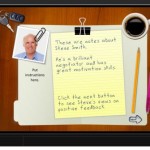[…] This post was mentioned on Twitter by Paulo Simões, Brian Batt, James Roughton, marco, Daniel Taylor and others. Daniel Taylor said: Help Your Client See E-Learning from a Different Perspective http://dlvr.it/F2Kww […]
Help Your Client See E-Learning from a Different Perspective
January 25th, 2011
Most people only see linear, click-and-read elearning courses. So when it comes time to build their own courses, they tend to build what they’ve seen before. The same goes for your clients or subject matter experts. They tend to expect something similar to what they’re used to seeing.
There are many times when a linear, click-and-read course is appropriate. So this isn’t a rant against click-and-read courses. However, there are also plenty of times, where a click-and-read course isn’t the best solution. In those cases, it can be a challenge getting your client to see past what he’s used to and considering a different approach.
Today, I’d like to offer a few ideas to help your client and subject matter experts understand what type of course they need to build.
Clarify the Course Objectives
What does the client expect as an outcome? I’ve worked on plenty of projects where the outcome was only to have the course tracked at the end of the year. And I’ve also worked on courses where the client expected real changes in performance.
In clarifying the objectives, steer the client away from courses that don’t offer any tangible value. If the course isn’t aligned to tangible goals, then most likely it’s a waste of time. But the reality is that sometimes you still have to build courses where the only real objective is that at the end of the year some group can say X people went through each course and got a 100% on the quiz.
In those cases, try to commit the least amount of resources possible. You can build simple courses that look good and meet your client’s goal without spending a lot of time and money. Your client will be happy and you free up your time and money for the more meaningful courses.

If you’re new to this, I recommend the Performance Consulting (2008) book. It does a great job walking through the process of helping your clients understand their performance goals and objectives. Knowing this will help them build impactful courses. I’ve also heard good things about The Performance Consultant’s Fieldbook.
Key points:
- Determine objectives
- Align objectives to performance goals
- Allocate resources appropriate to the objectives
Determine Which Type of Course is Best
If you listen to some in our industry, you’d think that any elearning course that isn’t performance-based is wrong. I don’t take that view. Instead, I see an elearning course just like any other medium used to support the learning process. It’s a tool to facilitate learning. Sometimes it’s the only tool, and sometimes it’s just one of many.
When it’s the only tool, then it makes sense to be as complete as possible. In those cases, the course probably needs more performance-based interactivity. However, if it’s augmented by other tools and activities, then perhaps an information-only focus is fine. And because, it’s information-only doesn’t mean it has to be linear.

Look at the way the news industry creates infographics. They’re not that much different than many elearning courses. Information-only doesn’t mean it has to be linear; or that all of the information needs to be buried in job aids or PDFs.
The question ultimately lies in the doing. What is the learner supposed to do with the course information and WHERE is it done? I can build a performance-based course where the doing is built into the elearning course with various interactive elements like branched scenarios and case studies. Or I can build an information-based course where the doing is outside the course in the real world. For example, I compress the delivery of information into simple elearning modules and combine them with some facilitated sessions in the real world.
Key points:
- What is the learner to do with the course content?
- Information-only can stand alone or be augmented with activities outside of the course.
- Performance-based expectations require appropriate interactivity inside the course.
Present Alternative Types of E-Learning
Going back to the opening paragraph, we tend to expect those things with which we’re familiar. Odds are that your client doesn’t have a lot of exposure to different types of elearning.
It’s your job to help them see the light. Expose them to different ideas and you’ll probably build better elearning. An easy way to do so is to offer a few treatments. Take some generic content and then build out a few versions of how it could be treated as an elearning course.

If they want an information-only course, show them some examples and how that type of course would support their learning goals. This is also a good way to open up the conversation about how they might need additional performance support if it’s not built into the elearning course. If they want a performance-based course, then provide a few examples of what that means and how different types of interactivity work in the course.
Doing this helps your client see elearning from a different perspective. It also helps clarify their goals and expectations, especially if resources like time and money are scarce. They may want something interactive, and find that they don’t have the budget or time to get there. On the flipside, they may have wanted a linear course, but after reviewing their goals and your examples, realize they need something better focused on performance.
Key points:
- Collect and share elearning examples
- Create a demo course with different treatments
- Discuss the different treatments and their associated resource requirements
The goal is to build a course appropriate to your client’s needs. Sometimes the need is simple and sometimes complex. By clarifying their objectives you’ll know what type of course to build. And by showing them examples, you’ll help them see elearning from various perspectives. In the end, all of this will help you build better elearning courses.
Events
- Everyday. Check out the weekly training webinars to learn more about Rise, Storyline, and instructional design.
Free E-Learning Resources
 |
 |
 |
|
Want to learn more? Check out these articles and free resources in the community. |
Here’s a great job board for e-learning, instructional design, and training jobs |
Participate in the weekly e-learning challenges to sharpen your skills |
 |
 |
 |
|
Get your free PowerPoint templates and free graphics & stock images. |
Lots of cool e-learning examples to check out and find inspiration. |
Getting Started? This e-learning 101 series and the free e-books will help. |
25 responses to “Help Your Client See E-Learning from a Different Perspective”
[…] Traduzione autorizzata tratta dal post originale di Tom Kuhlmann sul “Rapid E-Learning Blog”. Il post originale è disponibile qui […]
Leggi la traduzione (autorizzata) in italiano di questo post qui:
Hi Tom, Thanks, as usual 🙂 Very useful post.
I’d love to see the three different approaches to one course in more detail: is it available in another blog, or downloadable? I ask because coming up with new designs or approaches to a subject is the thing I have most difficulty with.
-A-
It would be so easy to give choices to managers, but what if you don’t have the tools ( for example, when I was hired to do WBT, I begged for articulate…but I got captivate and that took four months. They got me a video camera but no software to edit). My hands are tied by the tools I possess and they are very happy with straight read and learn, I, myself….am bored out of my gourd!
I could be producing amazing things…but, alas the higher ups just don’t get it!
Thanks Tom for the book links and tips – Cathy Moore has an interesting post on a similar theme, encouraging clients to focus on outcomes rather than content http://blog.cathy-moore.com/2009/10/how-to-steer-your-client-away-from-an-information-dump/#SlideFrame_1
Tom, as a newbie to my formal eLearning Designer position, I so appreciate the insight and practical tools that you share in your blog. Thanks for contributing to my success!!
Shari 🙂
Tom,
Sorry, but I must disagree with:
“If you listen to some in our industry, you’d think that any elearning course that isn’t performance-based is wrong. ”
I would say that all professionally developed industrial training should be performance based and clients have a right to expect performance based elearning in all cases.
In your latest blog, you seem to differentiate between training requirements that are information based based and performance based. To me, there is no distinction. When you provide a student information in a course, you should have an expectation they will be able to use that information or demonstrate understanding by sequencing, defining, identifying etc.
To me the distinction is more simple:
If the goal is to provide information, a web page will suffice (if you want to use flash or powerpoint, fine).
If the goal is to provide information, with an expectation that the information will be used in some prescribed manner, then eLearning or some other performance intervention is required. Please understand I am not advocating eLearning as a solution to all situations. As a performance technologist, I recognize eLearning is only one of many possible solutions to performance based problems.
Like many things in life, I guess it all boils down to expectations.
While we may disagree on this point, you’re contributions to the field of practice remain monumental.
Best Regards,
Joe Kirby
Working in Higher Education I encounter quite a few approaches to eLearning… the main challenge is to cover all bases that meet the uni’s expectation of a constructivist, collaborative learner-centred model.
Our concerns are with getting learners to position themselves at the heart of their learning and to engage at levels beyond mere application… rather we want them to synthesise and create… and more and more we’re asking them to adopt an interdisciplinary frame for knowledge they are building.
Information delivery is, albeit slowly, becoming a less important function of teaching – more and more we’re asking students to identify information themselves – to critically engage with the information they discover and be able to offer it to their peers and teachers with appropriate disciplinary consideration. Subsequent to discovery and critique comes a mode of engagement in action and reflexive praxis – the student’s own experience and understanding form the basis upon which knowledge is constructed… yes… we are saying that for rich engagement, extension and understanding students may well have to be reinventing the wheel – and who’s to say that there isn’t a better wheel to be invented?
Of course, a lot of corporate elearning is about getting learners to adopt a particular process and a particular frame… Education (capital “E”) is about the student’s journey and must allow for risk, ambiguity and uncertainty.
One of the most frightening things I see with undergrads is a desire for certainty in areas that have many dependencies… more eLearning really needs to embrace the “it depends…” frameset… open-ended enquiry.
I see where Joe is coming from. But I also see Tom’s intent with the comment:
“If you listen to some in our industry, you’d think that any elearning course that isn’t performance-based is wrong. ”
I think it comes down to granularity. Maybe we should say:
“An elearning course that isn’t goal oriented, that doesn’t create a measurable effect is wrong.”
Some courses or courselets contribute to a performance ontology in very small ways. We may, for example present a series on a concept within electronics theory. In the end, we intend that the learner will do something with this concept. But this may be a distant goal of that concept orientation. That distant goal might be “Troubleshoot and Fix the XYZ Gizmo”. While that small, granular, component may not directly support that performance – it certainly helps in building the performance picture.
In the end we want effect. How, and in what doses, we strategically affect the outcome varies. But there always should be an effect in mind. Performance improvement or skill building should be a strategic end goal in every case. But that doesn’t mean that a course can’t present a concept that contributes in a small or indirect way to the establishment or improvement of a skill or value.
I wouldn’t go so far as to conflate information with valuable knowledge. If you can’t make the connection to effect, even if it’s a loose connection, you should probably stop.
“In the end we want effect. How, and in what doses, we strategically affect the outcome varies.”
I would say that even when publishing a website or PowerPoint as information, we have the anticipation of benefit or effect. If we don’t we’re wasting our time and creating a maintenance trail for nothing. All effort should have a purpose.
@Joe: I’m going to disagree with you and agree with Tom. Some of the best eLearning modules I’ve ever seen are not performance oriented. It is imporatant to remember that not all learning within a workplace is necessarily about the ‘work’ and peformance based measurements therefore don’t apply. Values or attitudinal learning is also important and it is an area where eLearning can really add value.
A couple of classic examples include company history and Diversity training. Then there are training activities which are designed to socialise staff into new roles or departments (which can include an eLearning component).
I absolutely agree that performance measures should be in place for Skills and Knowledge training relating directly to work functions. However, learning in the workplace should and is a boarder spectrum than performance. For other types of training different measures will be required.
@Marla: I am a Captivate User. I know that this is primarily an Articulate blog – but I can employ of all of Tom’s tips in Captivate. Articulate has some fine features that Captivate does not and vice versa. However, having played with both (and I have no particular preference) they are both good products which allow you to reach a similar end product. If you are taking four months to do something in Captivate – it’s not necessarily the tool that’s taking you this long.
Hi Tom,
I like your Graphical presentation. It have Very little text and perfect graphical Presentation. And also I used your presentation pattern.
I need Some Suggestion To present My content. Here I m trying to do a E-Learning Course in “Flash” for the College Students. And for Math/Physics, contains lot of equation to Proof, as we know Proof may take 10-20 or more Steps. So to present 20 or more lines of Text How Can I have to present is 700/400 Screen. Please Help me to Present my Slide/Page which contains only Text(Lots of text).
Thanks
Subit
Hi Tom
The link to the performance consulting book points to the 1996 first edition. There is a newer edition here: Performance Consulting (2008). Regards
Hi Tom,
As usually, you write very interesting blogs. I was just my thoughts on design with someone to explain what Instructional Design is and how I come up with training design ideas. I look at websites, news sites, commercials, advertisements and/or marketing compaigns. These type of ideas give your training courses a face lift. You really have to change up things because employers get bored with seeing the same stuff. As a consultant I have learned that I have to give the employer something that they could not be accomplished by someone on the inside. Therefore, you have to constantly look for ideas to present e-learning that not only looks good but training that meets the performance goals and can be accomplished in a short period of time.
That is my 10 cents worth! Thank you again.
@Marla: You could actually do some really interesting things in PPT 2007 or 2003 until you get the software. Tom has some really interesting templates and ideas. These ideas can also be created or replicated into Captivate. It is -the idea that will make you shine not really the tools. The tools only serve as a shell to allow the extra bells and whistles. Also, get the book Better Than Bullet points. There are some really great ideas in the book that would woo your employer.
Best of Luck!
[…] […]
[…] Help Your Client See E-Learning from a Different Perspective […]
I’ve just been hired by a non-profit to launch their online learning for employees and volunteers. I was impressed with my free trial of Articulate and its simplicity in creating a course. What Articulate “boot camp” regimen would you recommend since I need to be up and running quickly? I’ll be a 1-man show for their online learning and I’ll have a limited budget for assets, etc.
Thanks!









0
comments